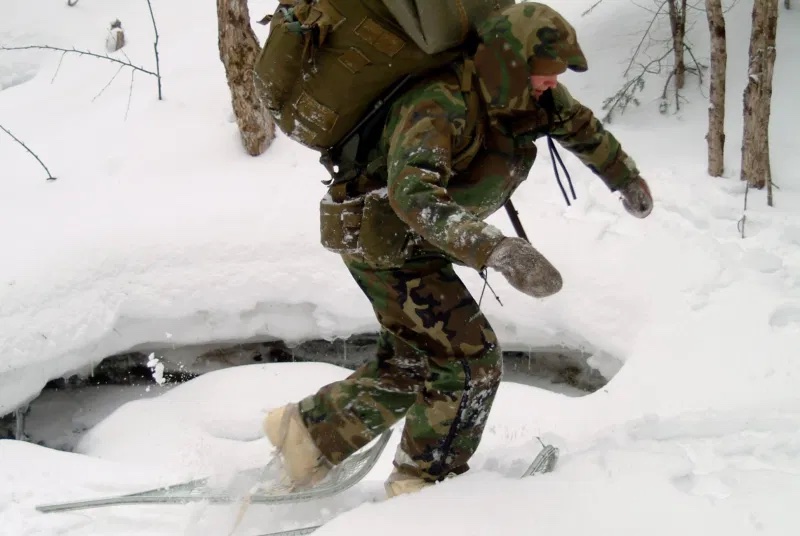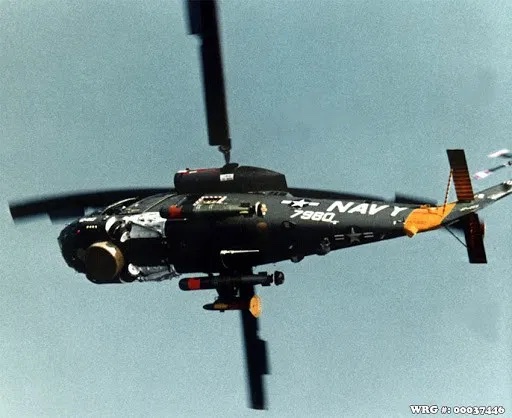By Sean Spoons via SOFREP

When my mother came into the bedroom that morning she found me in a pair of shorts and putting on a T-shirt. She hadn’t seen me in a year and had a big smile on her face. Then she saw the ugly yellowish bruises on my body and gasped before bursting into tears, “My God! What is the Navy doing to you, Sean?” I didn’t know what to say to her, but I knew what I wasn’t allowed to say: Mom, I just got back from SERE School.
This is the story of how I got those bruises, and made my mother cry.
It was a cold December in 1983 and I had two weeks’ leave that would take me out past New Years’. I was assigned to a Replacement Air Squadron (RAG), HSL-30 “Neptune’s Horsemen” and learning the ropes as an Aviation Anti-Submarine Warfare Operator in the SH2f LAMPS Seasprite helicopter. “LAMPS” was an acronym for Light Airborne Multi-Purpose System and reflected the Swiss Army knife capabilities of the Seasprite.
For its time, it was a fast helicopter that could cruise at 130kts and had retractable landing gear. It could also lift three tons, which was nearly its own weight, so it was very useful in lifting cargo from a supply ship to the destroyers and frigates it operated off. It could also be armed to the teeth. From its two hardpoints it could fire a pair of .50 cal machine guns with two M-60n machine guns firing out the door and port-side opening, two rocket pods, two Penguin anti-ship missiles, or two Mk-48 or Mk-50 torpedoes, and last but by no means least, even a B-57 nuclear depth bomb. The Navy didn’t even acknowledge that a Seasprite could carry the B-57, and as a crewman, we didn’t like to even think about it, since we doubted we would survive it going off.

The helicopter had a sensor suite that included radar, sonobuoys, and magnetic anomaly detection gear that, when its data was linked to the “Jezebel” processor on the ship, made it a truly deadly sub hunter. (Legend has it that the processor was so named because in the early days of the Sound Spectrogram systems used to record and analyze underwater sound, operators would pick up unidentified and terrifying shrieks and moans that they named “The Jezebel Monster.” These sounds were later discovered to be the songs of whales.)
The helicopter could even fly out beyond the horizon and do OTH, or Over The Horizon, targeting of an enemy vessel. The helicopter would sit at sea level in a hover, then pop up to 1,500 feet, turn on its radar for three sweeps of the antenna, and then drop back down to the deck. The sensor operator would use a grease pencil on the screen to mark contacts. Do this pop and sweep routine four or five times and you had a pretty good idea of the target’s course, speed, range, and bearing.
Aboard the target vessel, the radar operators would see a stationary and intermittent contact for a couple of seconds that would disappear and likely be dismissed as surface clutter or some other artifact and maybe a brief faint detection of a radar frequency on their ESM receiver. Meanwhile, using a secure data link we could relay that target information back to the ship and they could bring a salvo of missiles down on the bad guy without him even knowing a U.S. destroyer was lurking a couple of hundred miles away and outside his detection range. A lot is written about the weapons men carry into battle, we used to joke that in our case the weapon carried us.
So that is what I was learning about in Norfolk for four months of classroom, simulator, and actual flight missions. We did SAR (Search and Rescue) jumps into the cold brown waters of Chesapeake Bay and ran under a hovering Seasprite to sling cargo pallets under her exposed belly about six feet above you. We flew out to frigates and practice aircraft refueling while it hovered over the flight deck, called a “HIFR.” All of that was fun and dangerous stuff for a 19-year-old SAR swimmer almost at the end of the nearly two-year training pipeline to get into the fleet as a SAR-AW.
But there was one training evolution that hung over all of us with a bone-chilling sense of dread. Something we would all have to do and succeed at. One more big hurdle in two years of leaps and bounds over all kinds of obstacles in a training program that seemed designed to flunk you out and send you to a carrier flight deck to “chock and chain” out the rest of your enlistment as an aviation boatswain.
It was Survival Escape Resistance and Evasion, or SERE, school.
As is typical in a navy obsessed with acronyms the school had a name that was almost a cipher, FASOTRAGRUDETSERE, meaning, “Fleet Aviation Support Training Group Detachment Survival Escape Resistance and Evasion.” The school was located at Naval Air Station Brunswick in Maine. The actual training area was a classified location somewhere west of the Naval Air Station in the mountains. Its dread status was the stuff of fact, myth, and legend. Wild stories about it were common; tales about torture and about which bones they were allowed to break. But the basic truth of SERE school was that for 10 days you would know what it was like to be shot down behind enemy lines, have to survive and evade capture and finally, get a good taste for what it would be like to be a POW in the hands of the Soviet Union.
And we all dreaded getting that tap on the shoulder from a broadly grinning and senior NCO who would say, “Pack your shit, you’re on a bird to SERE tomorrow.” Other guys had gone before us who were still in training and we all pumped them for the “gouge” or information on what it was like. But they would mostly just smile and reply, “you’ll see.”
There were strict orders given to others who had been there not to discuss anything about it. In fact, the Navy wouldn’t even acknowledge publicly that the school existed. The only useful piece of intel I was able to obtain prior to going was to be told, “Don’t get thrown in the pond whatever you do.” And I had no idea what that even meant at the time.

So to prepare I checked out a copy of John Hubbell’s seminal work on POWs in Vietnam. It must have been 700 pages but I devoured it at night back at the barracks. I didn’t know what I might pick up from it, but what I read about POW experiences in Vietnam made my blood run cold.
You see, it was the lessons learned from the POWs in long captivity Vietnam that had led to the creation of the Navy’s SERE school. The school’s purpose was to train aircrews on how to evade capture and failing in that, how to resist interrogation under torture for what might be years and years.
Read Next: Helicopter Sea Combat Squadron 85 supports Navy SEAL Missions
One day I had just returned from a flight after practicing ground control approaches. My Chief Petty Officer came up to me smiling, and chiefs just don’t do that with E-3 Airmen like me. “Pack your shit Spoonts, you’re on a P-3 Orion to SERE tomorrow at 0700,” he said. “Get over to PSD and they’ll have travel orders for you.” I glanced around the room and saw some people smiling and others looking at me in pity like I had just been told I had an orange-sized tumor on my brain. At that moment, I remember feeling like I didn’t have a friend in the world. I dragged my ass over to Personnel Services to get my travel orders and a priority Space-Available flight chit, which would bump just about anybody off that P-3 except the pilots, to ensure I had seat on that plane.
I had been given a packing list for what to bring to SERE school: Dress A uniform (cracker jacks), Pea-Coat, white cover, wool watch cap, flight suit, boots and flight jacket, gloves, leather and wool liners, personal sundry stuff, no civilian apparel (as you are not authorized to leave the base and no liberty off base will be granted).
Everything fit in a fairly medium-sized duffle bag and I would wear my flight gear on the plane. I had a hard time sleeping that night imagining what was coming next. My apprehension was due to my imagination and the uncertainly of what lay ahead and that uncertainty kept me awake. 0530 hours would be coming soon. Listening to Pink Floyd’s “Wish You Were Here” album on my greatly prized Sony Walkman cassette player, I finally dozed off at about 0200.
This is Part I of a two-part series on the Navy’s SERE school. Stay tuned for Part II.
Sean is a former Navy Anti-submarine Warfare Operator and Search and Rescue Aircrewman in SH-2f LAMPS II Sea Sprite. Graduate of Naval Aircrewman Candidate School Pensacola, AW “A” School NATTC Millington, HS-1 SAR School NAS Jacksonville, FASOTRAGRUDET SERE NAS Bruswick. Duty with HSL-30, NAS Norfolk and HSL-36, NAF Mayport.
This post originally ran on www.sofrep.com
